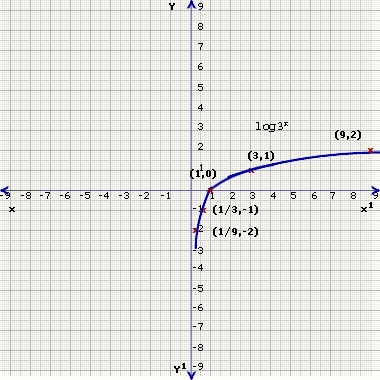Let y = f(x) be a function of x. For every x in the domain of f, there exists an ordered pair (x, f(x)). The set of points (x, f(x)) is called the graph of f.
By plotting these points on the Cartesian plane, we obtain the graph of f. y = f(x) is called the equation of the graph.
Example 1

Plot the points (1,√8 ), (2, √5), (3,0) (-1, √8), (-2 ,√5), (-3, 0) and join them to form a smooth curve.
y=f(x) = 
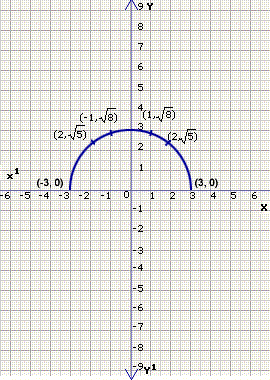
The graph is a semi-circle above the x-axis with radius 3 cm.

we get a semi-circle below the x-axis.
1.6.2 Graph of the step function or greatest integer function
Example 2
If y = f(x) = [x]
then f(x) = [x]
= n for n ≤ x < n + 1
Consider

Consider
f  = 0 for 0 ≤
= 0 for 0 ≤  < 1
< 1
f  = 0 for 0 ≤
= 0 for 0 ≤  < 1
< 1
f  = 0 for 0 ≤
= 0 for 0 ≤  < 1
< 1
Therefore, we find that the ordered pairs are

The graph of the step function is as follows: y = f(x) = [x]

The points (1,1), (2,2), (3,3), (-1,-1), (-2,-2) are included.
Example 3
The graph of y = f(x) = | x |
| x |
-3 |
-2 |
-1 |
0 |
1 |
2 |
3 |
| x | |
| -3 | |
| -2 | |
| -1 | |
| 0 | |
| 1 | |
| 2 | |
| 3 | |
y |
3 |
2 |
1 |
0 |
1 |
2 |
3 |
Plot the points (-3,3), (-2,2), (-1, 1), (0,0) (1,1), (2,2), (3,3) and join them to get the following figure.
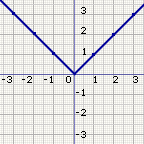
Example 4
Graph of ax (a>0).
Case (i) Let a > 1. For all positive or negative x ∈R, ax is always positive. Consider a = 2.
y = f(x) = 2x
x |
-2 |
-1 |
0 |
1 |
2 |
2x |
2-2 |
2-1 |
20 |
21 |
22 |
y |
1/4 |
1/2 |
1 |
2 |
4 |
Plot the points (-2 , 1/4), (-1,1/2), (0,1),(1,2) (2,4) on the graph and join them to form a smooth curve.
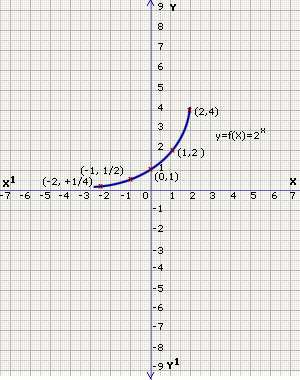
The graph of y = ax for any a > 1 is as follows.
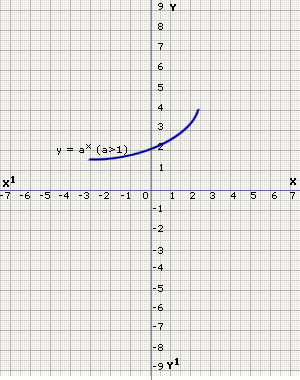
Case (ii) Let 0 < a < 1 for all positive or negative x ∈R, ax is always positive. The graph can be drawn as:
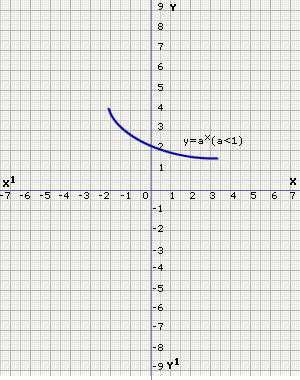
Consider a = ½, then 0 < 1/2 < 1.
If y = f(x) = (1/2)x
then
| x |
-2 |
-1 |
0 |
1 |
2 |
(1/2)x |
(1/2)-2 |
(1/2)-1 |
(1/2)0 |
(1/2)1 |
(1/2)2 |
y |
4 |
2 |
1 |
1/2 |
(1/4) |
since (1/2)-2 = (2)2 = 4
Plot the points (-2,4), (-1,2), (0,1), (1,1/2), (2,1/4) and join them to form a smooth curve.
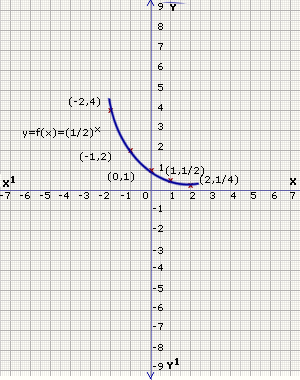
Example 5
Draw the graph of y = logax (a ≠ 0, a > 0)
The graph of y = loga xa > 1
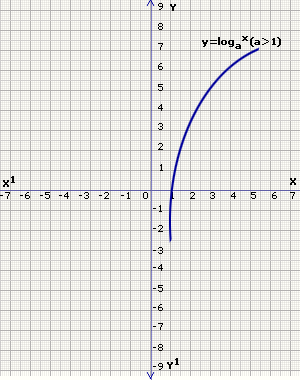
Consider a = 2 then y = f(x) = logzx
| x |
1/4 |
1/2 |
0 |
1 |
4 |
log2x |
log22-2 |
log22-1 |
log220 |
log22 |
log222 |
y |
-2 |
-1 |
0 |
1 |
2 |
Plot the points (1/4, -2), (1/2, -1), (0,0), (1,1), (4,2) on the graph.
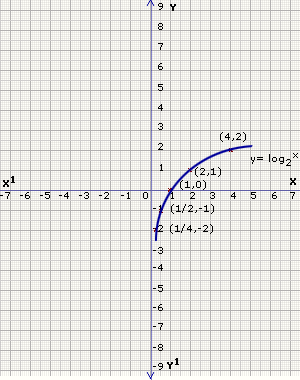
When 0 < a < 1, the graph of y = logax is
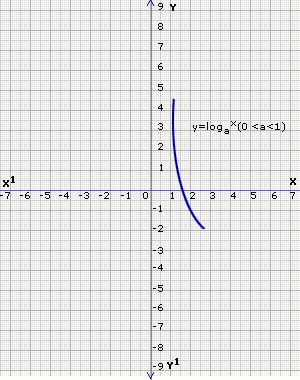
In particular, let a = 1/2.
y = log1/2x
| x |
1/4 |
1/2 |
1 |
2 |
4 |
log1/2x |
log1/2(1/2)2 |
log1/21/2 |
log1/21 |
log1/22 |
log1/24 |
y |
2 |
1 |
0 |
-1 |
-2 |
Since 2 = (1/2)-1 and 4 = (1/2)-2,
plot the points (1/4,2), (1/2,1), (1,0), (2,-1), (4,-2) and join them to obtain the graph.
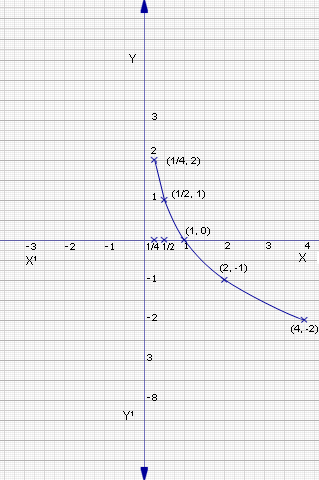
It is preferable if the student studies the graphs of exponential function f(x) = ax and logarithmic functions f(x) = logax with the help of Section 2.
Example 6
Sketch the graph of

Let y 
We cannot take negative values for x because no real number exists whose square is negative.
| x |
0 |
1 |
4 |
9 |
16 |
√x |
√0 |
√1 |
√4 |
√9 |
√16 |
y |
0 |
±1 |
±2 |
±3 |
±4 |
Plotting the points (0,0), (1,-1), (1,1), (4,-2), (4,2), (9,-3), (9,3) and (16,-4), (16,4) and joining them we get the following graph.
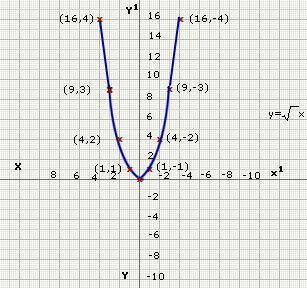
Example 7
Sketch the graph of y = 1/x.
| x |
-5 |
-2 |
-1 |
1 |
2 |
5 |
1/x |
1/-5 |
-1/2 |
-1 |
1 |
1/2 |
1/5 |
y |
-0.2 |
-0.5 |
-1 |
1 |
0.5 |
0.2 |
On plotting the points (-5, -0.2), (-2, -0.5), (-1, -1), (1,1), (2, 0.5), (5, 0.2) and joining them, we get:
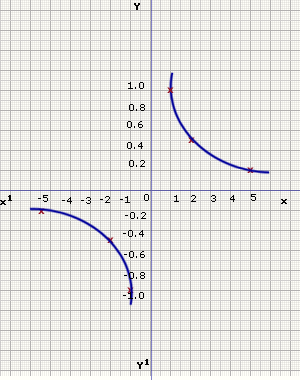
Try these questions
Sketch the Graphs of the following functions:
- y =

- y =

- y = 1/2x
- y = 3x
- y = log3x
Answers
- y =√x4
x |
-3 |
-2 |
-1 |
0 |
1 |
2 |
3 |
x4 |
(-3)4 |
(-2)4 |
(-1)4 |
(0)4 |
(1)4 |
24 |
34 |

|

|

|

|

|

|

|

|
y |
±9 |
±4 |
±1 |
0 |
±1 |
±4 |
±9 |
Plot the points (-3,9), (-3,-9), (-2,-4), (-2,4), (-1,-1), (-1,1), (0,0), (1,1), (1,-1), (2,-4), (3,9) and join them.
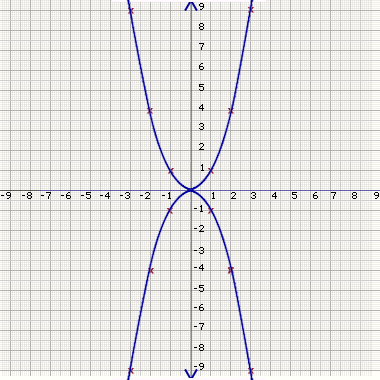
- y =

Taking only the positive square roots.
x |
-2 |
-1 |
0 |
1 |
2 |
x2 |
(-2)2 |
(-1)2 |
(0)2 |
(1)2 |
(2)2 |
4-x2 |
4-4 |
4-1 |
4-0 |
4-1 |
4-4 |

|

|

|

|

|

|
y |
0 |
1.7 |
2 |
1.7 |
0 |
Joining the points (-2,0), (-1,1.7), (0,2), (1,1.7), (2,0) we get the following graph.

- y = 1/2x
| x |
-3 |
-2 |
-1 |
1 |
2 |
3 |
2x |
-6 |
-4 |
-2 |
2 |
4 |
6 |
1/2x |
-1/6 |
-1/4 |
-1/2 |
1/2 |
1/4 |
1/6 |
y |
-0.16 |
-0.25 |
-0.5 |
0.5 |
0.25 |
0.16 |
Plotting the points (-3,-0.16), (-2,-0.25), (-1,-0.5), (1,0.5), (2,0.25), (3,0.16) and joining them we get
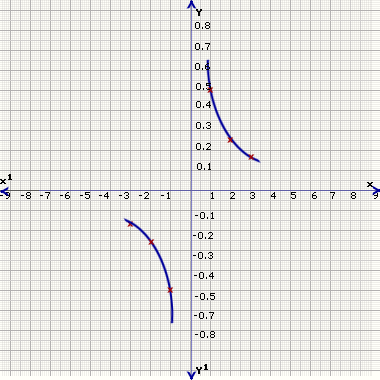
- y = 3x
x |
-2 |
-1 |
0 |
1 |
2 |
3x |
3-2 |
3-1 |
30 |
31 |
32 |
y |
0.1 |
0.3 |
1 |
3 |
9 |
Plot the points (-2,0.1), (-1,0.3), (0,1), (1,3), (2,9) and join to form a curve.
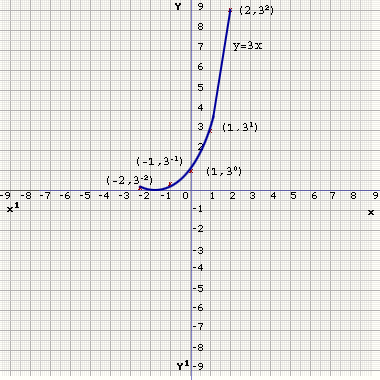
- y = log3x
| x |
1/9 |
1/3 |
1 |
3 |
9 |
log3x |
log33-2 |
log33-1 |
log330 |
log33 |
log332 |
y |
-2 |
-1 |
0 |
1 |
2 |
Plot the points (1/9, -2), (1/3, -1), (1, 0), (3, 1), (9, 2) and join to form a curve.
